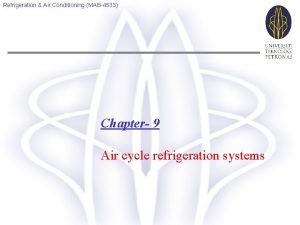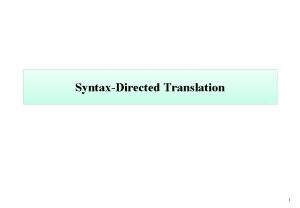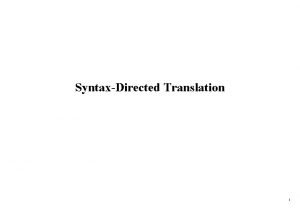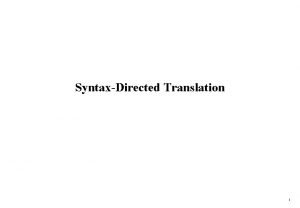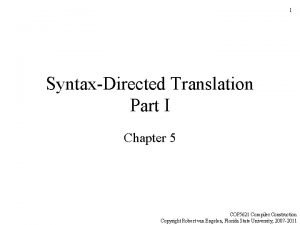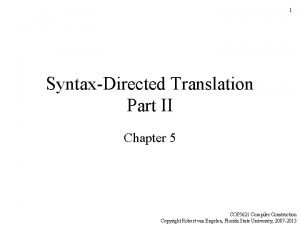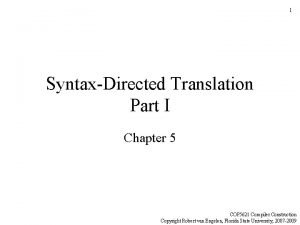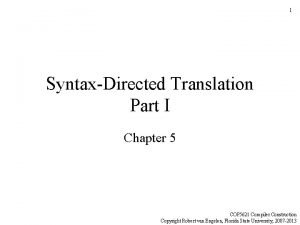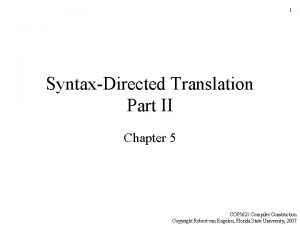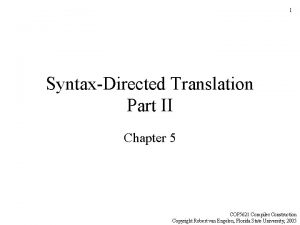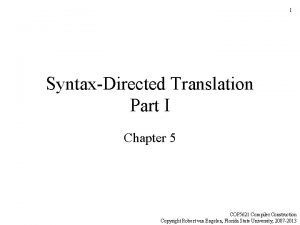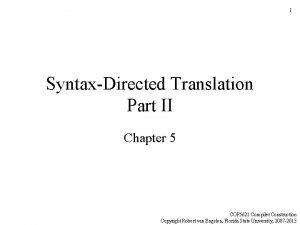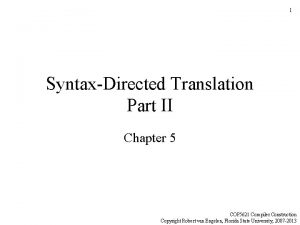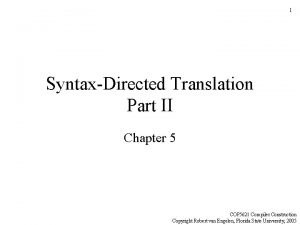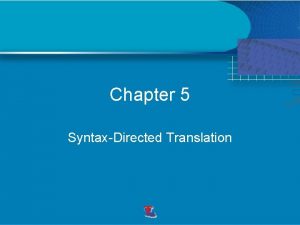1 SyntaxDirected Translation Part II Chapter 5 COP















- Slides: 15

1 Syntax-Directed Translation Part II Chapter 5 COP 5621 Compiler Construction Copyright Robert van Engelen, Florida State University, 2007 -2009

2 Translation Schemes using Marker Nonterminals Need a stack! (for nested if-then) S if E { emit(iconst_0); push(pc); emit(if_icmpeq, 0) } then S { backpatch(top(), pc-top()); pop() } Insert marker nonterminal Synthesized attribute (automatically stacked) S if E M then S { backpatch(M. loc, pc-M. loc) } M { emit(iconst_0); M. loc : = pc; emit(if_icmpeq, 0) }

3 Translation Schemes using Marker Nonterminals in Yacc S : IF E M THEN S { backpatch($3, pc-$3); } ; M : /* empty */ { emit(iconst_0); $$ = pc; emit 3(if_icmpeq, 0); } ; …

4 Replacing Inherited Attributes with Synthesized Lists D T L { for all id L. list : addtype(id. entry, T. type) } T int { T. type : = ‘integer’ } T real { T. type : = ‘real’ } L L 1 , id { L. list : = L 1. list + [id] } L id { L. list : = [id] } D T. type = ‘real’ L. list = [id 1, id 2, id 3] real L. list = [id 1, id 2] , L. list = [id 1] id 1. entry , id 2. entry id 3. entry

5 Replacing Inherited Attributes with Synthesized Lists in Yacc %{ typedef struct List { Symbol *entry; struct List *next; } List; %} %union { int type; List *list; Symbol *sym; } %token <sym> ID %type <list> L %type <type> T %% D : T L { List *p; for (p = $2; p; p = p->next) addtype(p->entry, $1); } ; T : INT { $$ = TYPE_INT; } | REAL { $$ = TYPE_REAL; } ; L : L ‘, ’ ID { $$ = malloc(sizeof(List)); $$->entry = $3; $$->next = $1; } | ID { $$ = malloc(sizeof(List)); $$->entry = $1; $$->next = NULL; } ;

6 Concrete and Abstract Syntax Trees • A parse tree is called a concrete syntax tree • An abstract syntax tree (AST) is defined by the compiler writer as a more convenient intermediate representation E + T T T * id id id Concrete syntax tree id * id id Abstract syntax tree

7 Generating Abstract Syntax Trees Synthesize AST E. nptr + T. nptr id T. nptr * id id + id * id id

8 S-Attributed Definitions for Generating Abstract Syntax Trees Production E E 1 + T E E 1 - T E T T T 1 * id T T 1 / id T id Semantic Rule E. nptr : = mknode(‘+’, E 1. nptr, T. nptr) E. nptr : = mknode(‘-’, E 1. nptr, T. nptr) E. nptr : = T. nptr : = mknode(‘*’, T 1. nptr, mkleaf(id, id. entry)) T. nptr : = mknode(‘/’, T 1. nptr, mkleaf(id, id. entry)) T. nptr : = mkleaf(id, id. entry)

9 Generating Abstract Syntax Trees with Yacc %{ typedef struct Node { int op; /* node op */ Symbol *entry; /* leaf */ struct Node *left, *right; } Node; %} %union { Node *node; Symbol *sym; } E : | | ; T : | | ; F : | ; %% %token <sym> ID %type <node> E T F %% E ‘+’ T E ‘-’ T T { $$ = mknode(‘+’, $1, $3); } { $$ = mknode(‘-’, $1, $3); } { $$ = $1; } T ‘*’ F T ‘/’ F F { $$ = mknode(‘*’, $1, $3); } { $$ = mknode(‘/’, $1, $3); } { $$ = $1; } ‘(’ E ‘)’ { $$ = $2; } ID { $$ = mkleaf($1); }

10 Eliminating Left Recursion from a Translation Scheme A A 1 Y A X { A. a : = g(A 1. a, Y. y) } { A. a : = f(X. x) } A X { R. i : = f(X. x) } R { A. a : = R. s } R Y { R 1. i : = g(R. i, Y. y) } R 1 { R. s : = R 1. s } R { R. s : = R. i }

11 Eliminating Left Recursion from a Translation Scheme (cont’d) A. a = g(g(f(X. x), Y 1. y), Y 2. y) A. a = g(f(X. x), Y 1. y) A. a = f(X. x) X Y 1 Y 2

12 Eliminating Left Recursion from a Translation Scheme (cont’d) A X R 1. i = f(X. x) Y 1 R 2. i = g(f(X. x), Y 1. y) Y 2 1. Flow of inherited attribute values R 3. i = g(g(f(X. x), Y 1. y), Y 2. y)

13 Eliminating Left Recursion from a Translation Scheme (cont’d) A. s = R 1. s = g(g(f(X. x), Y 1. y), Y 2. y) X R 1. s = R 2. s = g(g(f(X. x), Y 1. y), Y 2. y) Y 1 R 2. s = R 3. s = g(g(f(X. x), Y 1. y), Y 2. y) Y 2 2. Flow of synthesized attribute values R 3. s = R 3. i = g(g(f(X. x), Y 1. y), Y 2. y)

14 Generating Abstract Syntax Trees with Predictive Parsers E E 1 + T { E. nptr : = mknode(‘+’, E 1. nptr, T. nptr) } E E 1 - T { E. nptr : = mknode(‘-’, E 1. nptr, T. nptr) } E T { E. nptr : = T. nptr } T id { T. nptr : = mkleaf(id, id. entry) } E T { R. i : = T. nptr } R { E. nptr : = R. s } R + T {R 1. i : = mknode(‘+’, R. i, T. nptr) } R 1 { R. s : = R 1. s } R - T {R 1. i : = mknode(‘-’, R. i, T. nptr) } R 1 { R. s : = R 1. s } R { R. s : = R. i } T id { T. nptr : = mkleaf(id, id. entry) }

15 Generating Abstract Syntax Trees with Predictive Parsers (cont’d) Node *R(Node *i) { Node *s, *i 1; if (lookahead == ‘+’) { match(‘+’); s = T(); i 1 = mknode(‘+’, i, s); s = R(i 1); } else if (lookahead == ‘-’) { … } else s = i; return s; }
 Good cop bad cop interrogation
Good cop bad cop interrogation Cop 1 cop 2
Cop 1 cop 2 Communicative translation
Communicative translation Cisco voice translation-rule
Cisco voice translation-rule Function transformations
Function transformations Noun to noun
Noun to noun Part part whole addition
Part part whole addition Part to part ratio definition
Part to part ratio definition Part part whole
Part part whole Technical description examples
Technical description examples Different parts of a bar
Different parts of a bar The part of a shadow surrounding the darkest part
The part of a shadow surrounding the darkest part Minitab adalah
Minitab adalah Coefficient of performance of refrigerator
Coefficient of performance of refrigerator Aircraft refrigeration system
Aircraft refrigeration system Isppia
Isppia














